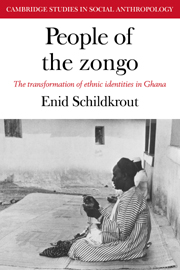Book contents
- Frontmatter
- Contents
- List of tables, figures, and maps
- Preface
- Glossary
- I Ethnicity and migration
- 1 Introduction: conceptual approaches to the study of ethnicity
- 2 The Mossi: ethnicity in Voltaic society
- 3 Migration and settlement of Mossi in Ghana
- II Kinship and community
- III Politics and change
- Notes
- Bibliography
- Index
2 - The Mossi: ethnicity in Voltaic society
Published online by Cambridge University Press: 29 October 2009
- Frontmatter
- Contents
- List of tables, figures, and maps
- Preface
- Glossary
- I Ethnicity and migration
- 1 Introduction: conceptual approaches to the study of ethnicity
- 2 The Mossi: ethnicity in Voltaic society
- 3 Migration and settlement of Mossi in Ghana
- II Kinship and community
- III Politics and change
- Notes
- Bibliography
- Index
Summary
While the Mossi view themselves as a single ethnic unit when they are in contact with others, Mossi society itself is internally divided into a number of different subcategories, none of which identifies itself simply as Mossi. The unity apparent to outsiders reflects the fact that members of these various Mossi collectivities have more in common with one another than they have with non-Mossi. This unity is the result of a long and complex process of incorporation which has been characteristic of Mossi society since its beginning in the fourteenth or fifteenth century (Fage 1964; Illiasu 1971).
Although the distinctions between ethnic communities within traditional Mossi society are not of great importance to the organization of the immigrant Mossi community in Kumasi, the process of incorporation that has characterized the growth of the Mossi state is relevant. In a number of significant ways the processes of integration taking place in both communities are similar. In the Kumasi immigrant community and in Mossi society in Upper Volta, ethnic communities have increasingly lost their cultural individuality as they have been incorporated into larger sociopolitical units. At the same time, ethnic categories have become elements of the social structure of the larger community, wherein they are a means of expressing status distinctions between groups and allocating distinctive social, political, and economic roles.
In Mossi society, as among immigrants in Kumasi, ethnic categories are perpetuated through patrifiliation.
- Type
- Chapter
- Information
- People of the ZongoThe Transformation of Ethnic Identities in Ghana, pp. 18 - 37Publisher: Cambridge University PressPrint publication year: 1978



